Analyzing Cultural Diversity's Impact on Innovation at Volkswagen
VerifiedAdded on 2023/01/10
|21
|6829
|48
Report
AI Summary
This report investigates the contribution of cultural diversity to the promotion of innovation within Volkswagen. The study explores the concept of workplace diversity, examining its impact on the working environment, and how it fosters innovation. The research addresses the benefits of a diverse workforce, such as increased creativity and competitive advantage, while also acknowledging potential challenges. The methodology includes a literature review and outlines the research questions, objectives, and significance of the study. The findings are presented, followed by a discussion and conclusions, offering recommendations for leveraging cultural diversity to enhance innovation and achieve business success. The report emphasizes the importance of managing diversity effectively to drive growth and maintain a competitive edge in the automotive industry.
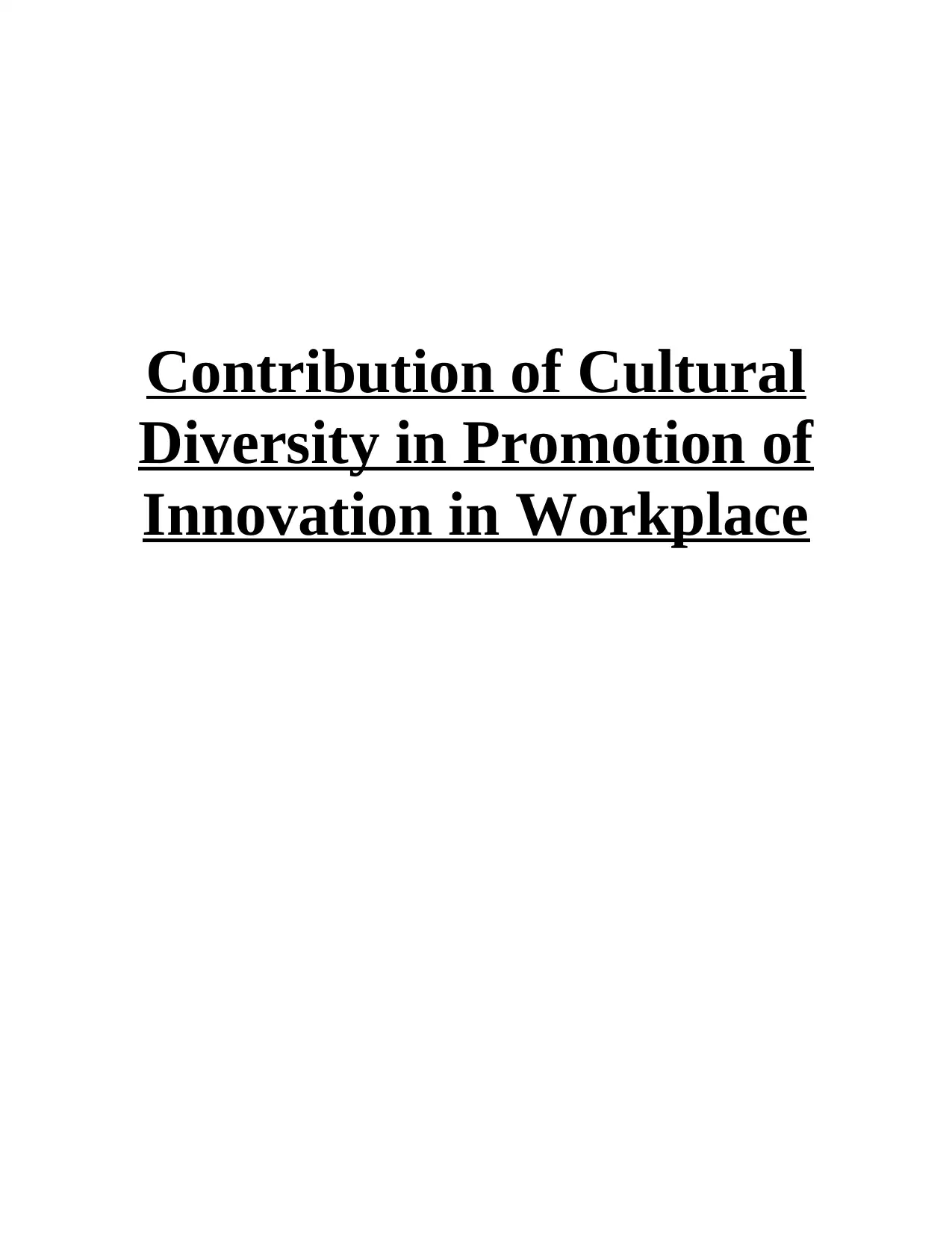
Contribution of Cultural
Diversity in Promotion of
Innovation in Workplace
Diversity in Promotion of
Innovation in Workplace
Paraphrase This Document
Need a fresh take? Get an instant paraphrase of this document with our AI Paraphraser

Contents
Abstract............................................................................................................................................4
1.1 Title of study..............................................................................................................................1
1.2 Introduction................................................................................................................................1
1.2.1 Background.........................................................................................................................1
1.2.2 Questions of Research........................................................................................................2
1.2.3 Aim of study.......................................................................................................................2
1.2.4 Objectives of Research.......................................................................................................2
1.2.5 Significance of research......................................................................................................2
2.0 Critical Review of literature......................................................................................................3
2.1 Introduction............................................................................................................................3
2.2.2 The concept of workplace diversity....................................................................................3
2.2.3 impact of maintaining cultural diversity on work environment of company.....................4
2.2.4 the way cultural diversity assists in promotion of innovation in company........................5
2.2.5 The way workplace helps the organisation in attaining success in market........................6
2.2.6 Conceptual framework of diversity in workplace..............................................................7
3.0 Research Methodology..............................................................................................................8
3.1 Ethical Consideration...............................................................................................................10
3.2 Timeline...................................................................................................................................10
.......................................................................................................................................................11
4.0 Results and Findings................................................................................................................12
5.0 Discussion................................................................................................................................13
6.0 Conclusion and Recommendations of research.......................................................................14
Conclusion.................................................................................................................................14
Recommendation.......................................................................................................................15
REFERENCES..............................................................................................................................16
Abstract............................................................................................................................................4
1.1 Title of study..............................................................................................................................1
1.2 Introduction................................................................................................................................1
1.2.1 Background.........................................................................................................................1
1.2.2 Questions of Research........................................................................................................2
1.2.3 Aim of study.......................................................................................................................2
1.2.4 Objectives of Research.......................................................................................................2
1.2.5 Significance of research......................................................................................................2
2.0 Critical Review of literature......................................................................................................3
2.1 Introduction............................................................................................................................3
2.2.2 The concept of workplace diversity....................................................................................3
2.2.3 impact of maintaining cultural diversity on work environment of company.....................4
2.2.4 the way cultural diversity assists in promotion of innovation in company........................5
2.2.5 The way workplace helps the organisation in attaining success in market........................6
2.2.6 Conceptual framework of diversity in workplace..............................................................7
3.0 Research Methodology..............................................................................................................8
3.1 Ethical Consideration...............................................................................................................10
3.2 Timeline...................................................................................................................................10
.......................................................................................................................................................11
4.0 Results and Findings................................................................................................................12
5.0 Discussion................................................................................................................................13
6.0 Conclusion and Recommendations of research.......................................................................14
Conclusion.................................................................................................................................14
Recommendation.......................................................................................................................15
REFERENCES..............................................................................................................................16
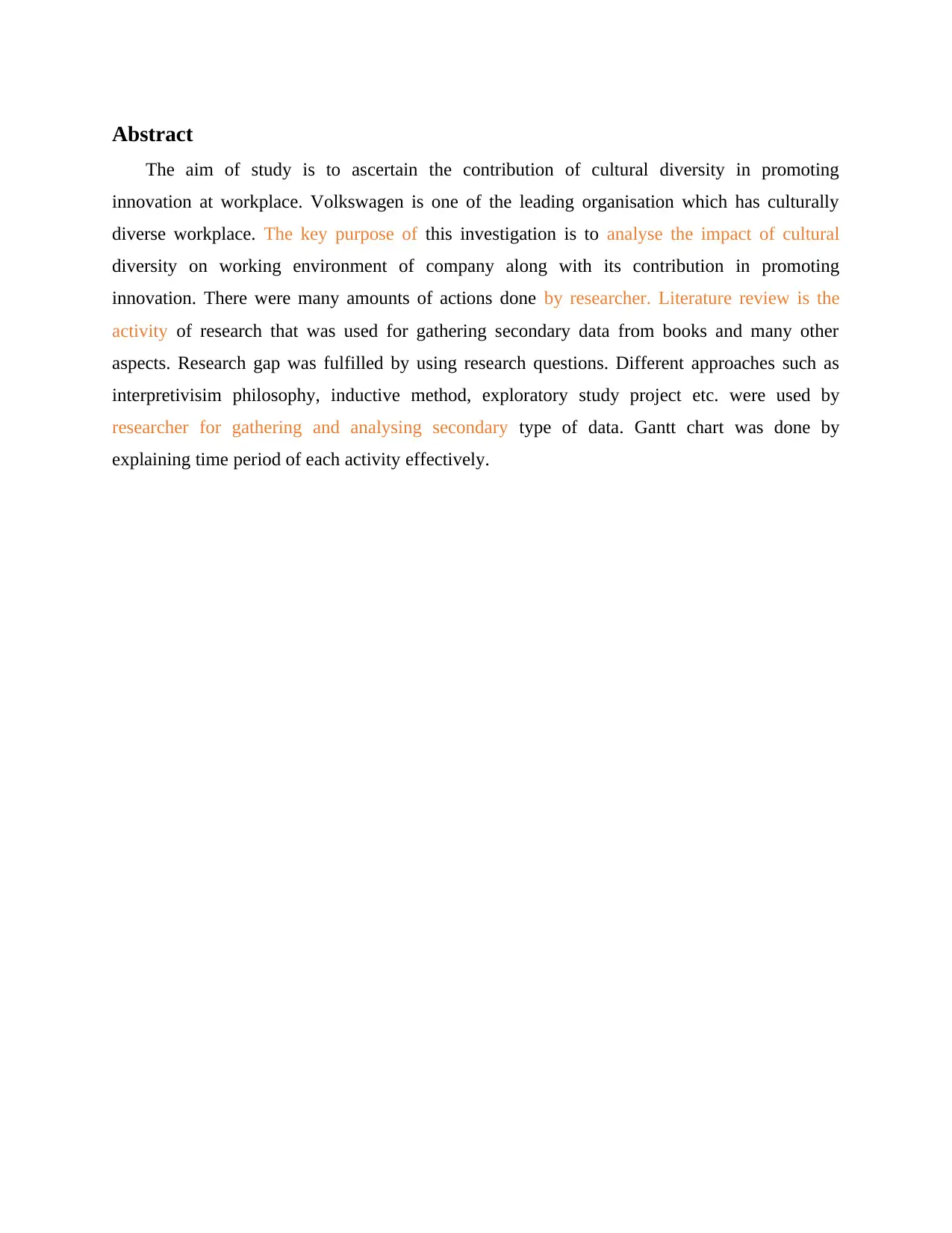
Abstract
The aim of study is to ascertain the contribution of cultural diversity in promoting
innovation at workplace. Volkswagen is one of the leading organisation which has culturally
diverse workplace. The key purpose of this investigation is to analyse the impact of cultural
diversity on working environment of company along with its contribution in promoting
innovation. There were many amounts of actions done by researcher. Literature review is the
activity of research that was used for gathering secondary data from books and many other
aspects. Research gap was fulfilled by using research questions. Different approaches such as
interpretivisim philosophy, inductive method, exploratory study project etc. were used by
researcher for gathering and analysing secondary type of data. Gantt chart was done by
explaining time period of each activity effectively.
The aim of study is to ascertain the contribution of cultural diversity in promoting
innovation at workplace. Volkswagen is one of the leading organisation which has culturally
diverse workplace. The key purpose of this investigation is to analyse the impact of cultural
diversity on working environment of company along with its contribution in promoting
innovation. There were many amounts of actions done by researcher. Literature review is the
activity of research that was used for gathering secondary data from books and many other
aspects. Research gap was fulfilled by using research questions. Different approaches such as
interpretivisim philosophy, inductive method, exploratory study project etc. were used by
researcher for gathering and analysing secondary type of data. Gantt chart was done by
explaining time period of each activity effectively.
⊘ This is a preview!⊘
Do you want full access?
Subscribe today to unlock all pages.

Trusted by 1+ million students worldwide

1.1 Title of study
A study on contribution of cultural diversity in promotion of innovation in workplace. A
study on Volkswagen.
1.2 Introduction
1.2.1 Background
Diversity in the workplace is employing employees who belong to different cultures and
are not similar with each other. These differences may be associated with the national origin,
education, age, gender, physical appearance, sexual orientation or religion of an individual.
Cultural diversity is defined as the diverse cultures, as opposed to global monoculture or a
homogenization of culture. Cultural diversity within the workplace is an outputs of values,
practices, beliefs or traditions of workers based on race, ethnicity, religion, age or gender. The
modern workforce is made up of people of different genders, ages, ethnicity, religions, and
nationalities. There are different benefits of having diverse workforce at workplace for an
organisation such as increase productivity, increase creativity, a Varity of perspectives, help in
boosting brand reputation, increase innovation etc. These are major benefits of workplace
diversity that helps an enterprise in improvement of its success at national as well as global level
(Al-Jenaibi, 2017). However, there are number of issues that can be face by a company like high
employee turnover, poor innovation, reduced success, lack of growth, etc. if it is having lack of
cultural diversity. All these are major issues that an organisation may face is due to lack of
diverse staff in the workplace (Cho, Kim and Mor Barak, 2017). For addressing these issues and
ensuring growth and success of company, it is very crucial to properly execute and manage
diversity in workplace as it will assist organisation by enhancing innovation, gaining competitive
advantage and increasing creativity etc. that ultimately leads the company to success and growth.
This research grounded on automotive industry that comprises a wide range of
organisations and companies involved in the development, manufacturing, promoting and selling
of motor vehicles. Volkswagen is a given automotive organisation that was founded in 1937 by
German Labour Front.
Key basis for choosing this topic is to increase awareness regarding the impact of diversity
at workplace. This research is wide scope because it will help individual, organisations and
societies by providing information regarding the workplace diversity in promoting of innovation
1
A study on contribution of cultural diversity in promotion of innovation in workplace. A
study on Volkswagen.
1.2 Introduction
1.2.1 Background
Diversity in the workplace is employing employees who belong to different cultures and
are not similar with each other. These differences may be associated with the national origin,
education, age, gender, physical appearance, sexual orientation or religion of an individual.
Cultural diversity is defined as the diverse cultures, as opposed to global monoculture or a
homogenization of culture. Cultural diversity within the workplace is an outputs of values,
practices, beliefs or traditions of workers based on race, ethnicity, religion, age or gender. The
modern workforce is made up of people of different genders, ages, ethnicity, religions, and
nationalities. There are different benefits of having diverse workforce at workplace for an
organisation such as increase productivity, increase creativity, a Varity of perspectives, help in
boosting brand reputation, increase innovation etc. These are major benefits of workplace
diversity that helps an enterprise in improvement of its success at national as well as global level
(Al-Jenaibi, 2017). However, there are number of issues that can be face by a company like high
employee turnover, poor innovation, reduced success, lack of growth, etc. if it is having lack of
cultural diversity. All these are major issues that an organisation may face is due to lack of
diverse staff in the workplace (Cho, Kim and Mor Barak, 2017). For addressing these issues and
ensuring growth and success of company, it is very crucial to properly execute and manage
diversity in workplace as it will assist organisation by enhancing innovation, gaining competitive
advantage and increasing creativity etc. that ultimately leads the company to success and growth.
This research grounded on automotive industry that comprises a wide range of
organisations and companies involved in the development, manufacturing, promoting and selling
of motor vehicles. Volkswagen is a given automotive organisation that was founded in 1937 by
German Labour Front.
Key basis for choosing this topic is to increase awareness regarding the impact of diversity
at workplace. This research is wide scope because it will help individual, organisations and
societies by providing information regarding the workplace diversity in promoting of innovation
1
Paraphrase This Document
Need a fresh take? Get an instant paraphrase of this document with our AI Paraphraser
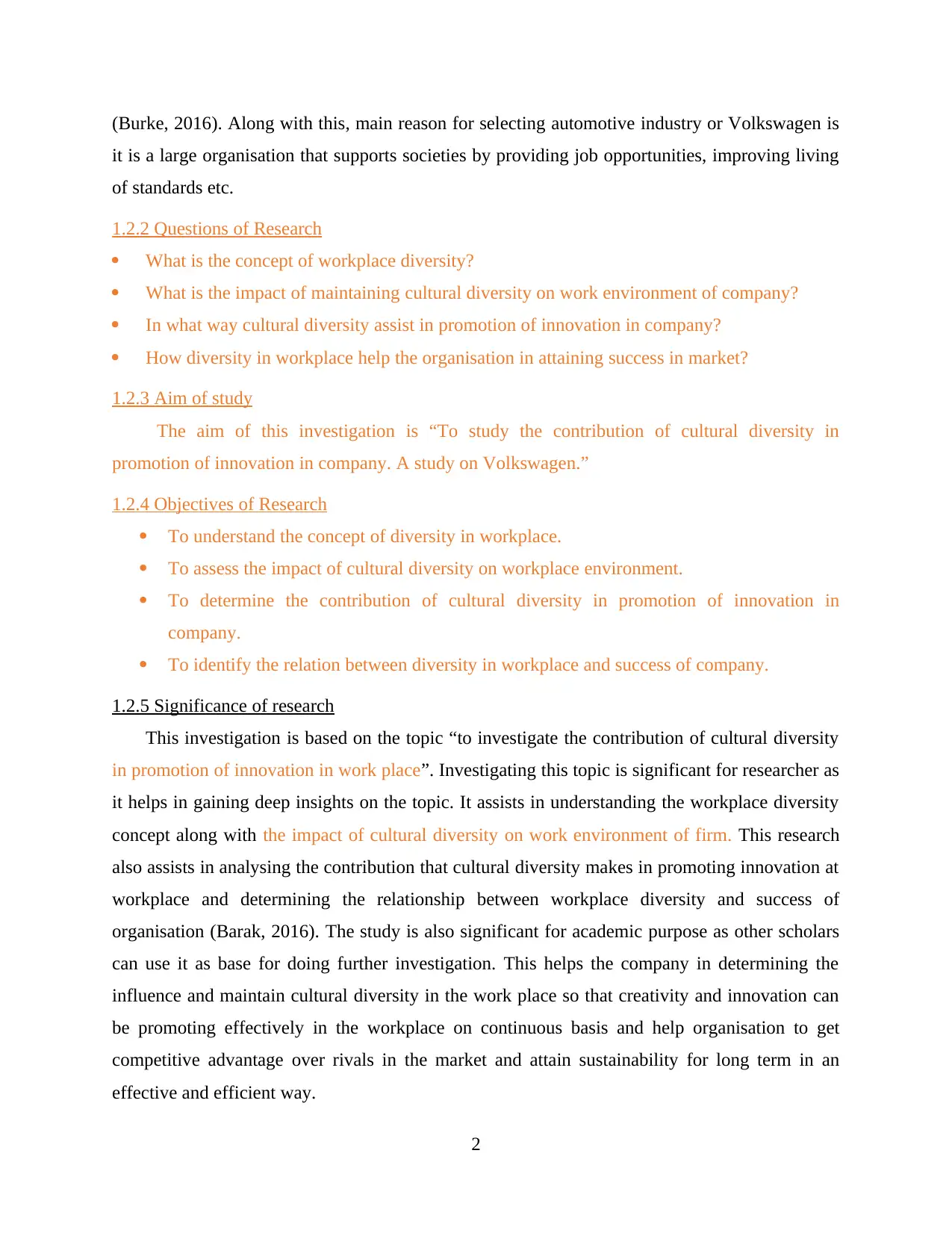
(Burke, 2016). Along with this, main reason for selecting automotive industry or Volkswagen is
it is a large organisation that supports societies by providing job opportunities, improving living
of standards etc.
1.2.2 Questions of Research
What is the concept of workplace diversity?
What is the impact of maintaining cultural diversity on work environment of company?
In what way cultural diversity assist in promotion of innovation in company?
How diversity in workplace help the organisation in attaining success in market?
1.2.3 Aim of study
The aim of this investigation is “To study the contribution of cultural diversity in
promotion of innovation in company. A study on Volkswagen.”
1.2.4 Objectives of Research
To understand the concept of diversity in workplace.
To assess the impact of cultural diversity on workplace environment.
To determine the contribution of cultural diversity in promotion of innovation in
company.
To identify the relation between diversity in workplace and success of company.
1.2.5 Significance of research
This investigation is based on the topic “to investigate the contribution of cultural diversity
in promotion of innovation in work place”. Investigating this topic is significant for researcher as
it helps in gaining deep insights on the topic. It assists in understanding the workplace diversity
concept along with the impact of cultural diversity on work environment of firm. This research
also assists in analysing the contribution that cultural diversity makes in promoting innovation at
workplace and determining the relationship between workplace diversity and success of
organisation (Barak, 2016). The study is also significant for academic purpose as other scholars
can use it as base for doing further investigation. This helps the company in determining the
influence and maintain cultural diversity in the work place so that creativity and innovation can
be promoting effectively in the workplace on continuous basis and help organisation to get
competitive advantage over rivals in the market and attain sustainability for long term in an
effective and efficient way.
2
it is a large organisation that supports societies by providing job opportunities, improving living
of standards etc.
1.2.2 Questions of Research
What is the concept of workplace diversity?
What is the impact of maintaining cultural diversity on work environment of company?
In what way cultural diversity assist in promotion of innovation in company?
How diversity in workplace help the organisation in attaining success in market?
1.2.3 Aim of study
The aim of this investigation is “To study the contribution of cultural diversity in
promotion of innovation in company. A study on Volkswagen.”
1.2.4 Objectives of Research
To understand the concept of diversity in workplace.
To assess the impact of cultural diversity on workplace environment.
To determine the contribution of cultural diversity in promotion of innovation in
company.
To identify the relation between diversity in workplace and success of company.
1.2.5 Significance of research
This investigation is based on the topic “to investigate the contribution of cultural diversity
in promotion of innovation in work place”. Investigating this topic is significant for researcher as
it helps in gaining deep insights on the topic. It assists in understanding the workplace diversity
concept along with the impact of cultural diversity on work environment of firm. This research
also assists in analysing the contribution that cultural diversity makes in promoting innovation at
workplace and determining the relationship between workplace diversity and success of
organisation (Barak, 2016). The study is also significant for academic purpose as other scholars
can use it as base for doing further investigation. This helps the company in determining the
influence and maintain cultural diversity in the work place so that creativity and innovation can
be promoting effectively in the workplace on continuous basis and help organisation to get
competitive advantage over rivals in the market and attain sustainability for long term in an
effective and efficient way.
2
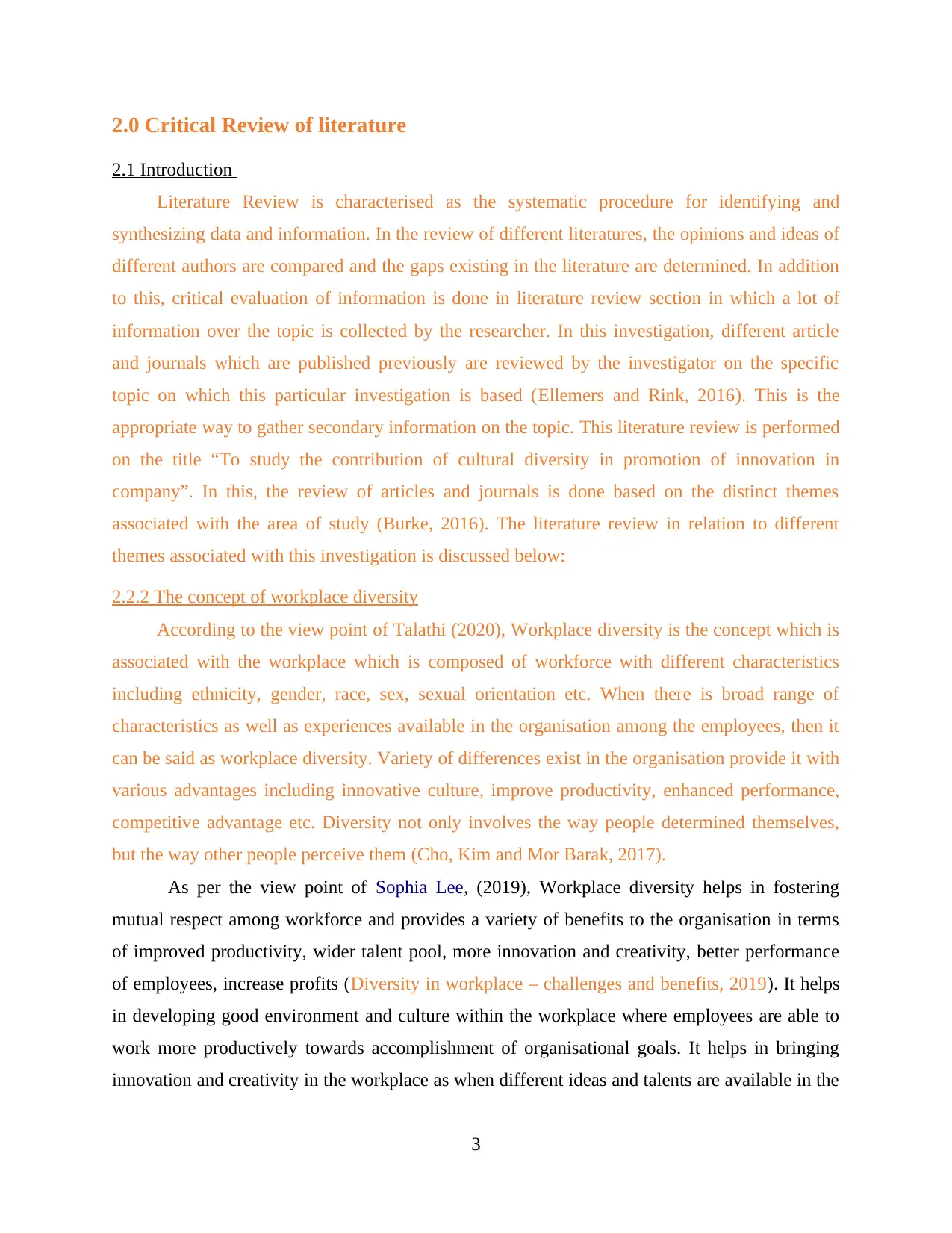
2.0 Critical Review of literature
2.1 Introduction
Literature Review is characterised as the systematic procedure for identifying and
synthesizing data and information. In the review of different literatures, the opinions and ideas of
different authors are compared and the gaps existing in the literature are determined. In addition
to this, critical evaluation of information is done in literature review section in which a lot of
information over the topic is collected by the researcher. In this investigation, different article
and journals which are published previously are reviewed by the investigator on the specific
topic on which this particular investigation is based (Ellemers and Rink, 2016). This is the
appropriate way to gather secondary information on the topic. This literature review is performed
on the title “To study the contribution of cultural diversity in promotion of innovation in
company”. In this, the review of articles and journals is done based on the distinct themes
associated with the area of study (Burke, 2016). The literature review in relation to different
themes associated with this investigation is discussed below:
2.2.2 The concept of workplace diversity
According to the view point of Talathi (2020), Workplace diversity is the concept which is
associated with the workplace which is composed of workforce with different characteristics
including ethnicity, gender, race, sex, sexual orientation etc. When there is broad range of
characteristics as well as experiences available in the organisation among the employees, then it
can be said as workplace diversity. Variety of differences exist in the organisation provide it with
various advantages including innovative culture, improve productivity, enhanced performance,
competitive advantage etc. Diversity not only involves the way people determined themselves,
but the way other people perceive them (Cho, Kim and Mor Barak, 2017).
As per the view point of Sophia Lee, (2019), Workplace diversity helps in fostering
mutual respect among workforce and provides a variety of benefits to the organisation in terms
of improved productivity, wider talent pool, more innovation and creativity, better performance
of employees, increase profits (Diversity in workplace – challenges and benefits, 2019). It helps
in developing good environment and culture within the workplace where employees are able to
work more productively towards accomplishment of organisational goals. It helps in bringing
innovation and creativity in the workplace as when different ideas and talents are available in the
3
2.1 Introduction
Literature Review is characterised as the systematic procedure for identifying and
synthesizing data and information. In the review of different literatures, the opinions and ideas of
different authors are compared and the gaps existing in the literature are determined. In addition
to this, critical evaluation of information is done in literature review section in which a lot of
information over the topic is collected by the researcher. In this investigation, different article
and journals which are published previously are reviewed by the investigator on the specific
topic on which this particular investigation is based (Ellemers and Rink, 2016). This is the
appropriate way to gather secondary information on the topic. This literature review is performed
on the title “To study the contribution of cultural diversity in promotion of innovation in
company”. In this, the review of articles and journals is done based on the distinct themes
associated with the area of study (Burke, 2016). The literature review in relation to different
themes associated with this investigation is discussed below:
2.2.2 The concept of workplace diversity
According to the view point of Talathi (2020), Workplace diversity is the concept which is
associated with the workplace which is composed of workforce with different characteristics
including ethnicity, gender, race, sex, sexual orientation etc. When there is broad range of
characteristics as well as experiences available in the organisation among the employees, then it
can be said as workplace diversity. Variety of differences exist in the organisation provide it with
various advantages including innovative culture, improve productivity, enhanced performance,
competitive advantage etc. Diversity not only involves the way people determined themselves,
but the way other people perceive them (Cho, Kim and Mor Barak, 2017).
As per the view point of Sophia Lee, (2019), Workplace diversity helps in fostering
mutual respect among workforce and provides a variety of benefits to the organisation in terms
of improved productivity, wider talent pool, more innovation and creativity, better performance
of employees, increase profits (Diversity in workplace – challenges and benefits, 2019). It helps
in developing good environment and culture within the workplace where employees are able to
work more productively towards accomplishment of organisational goals. It helps in bringing
innovation and creativity in the workplace as when different ideas and talents are available in the
3
⊘ This is a preview!⊘
Do you want full access?
Subscribe today to unlock all pages.

Trusted by 1+ million students worldwide
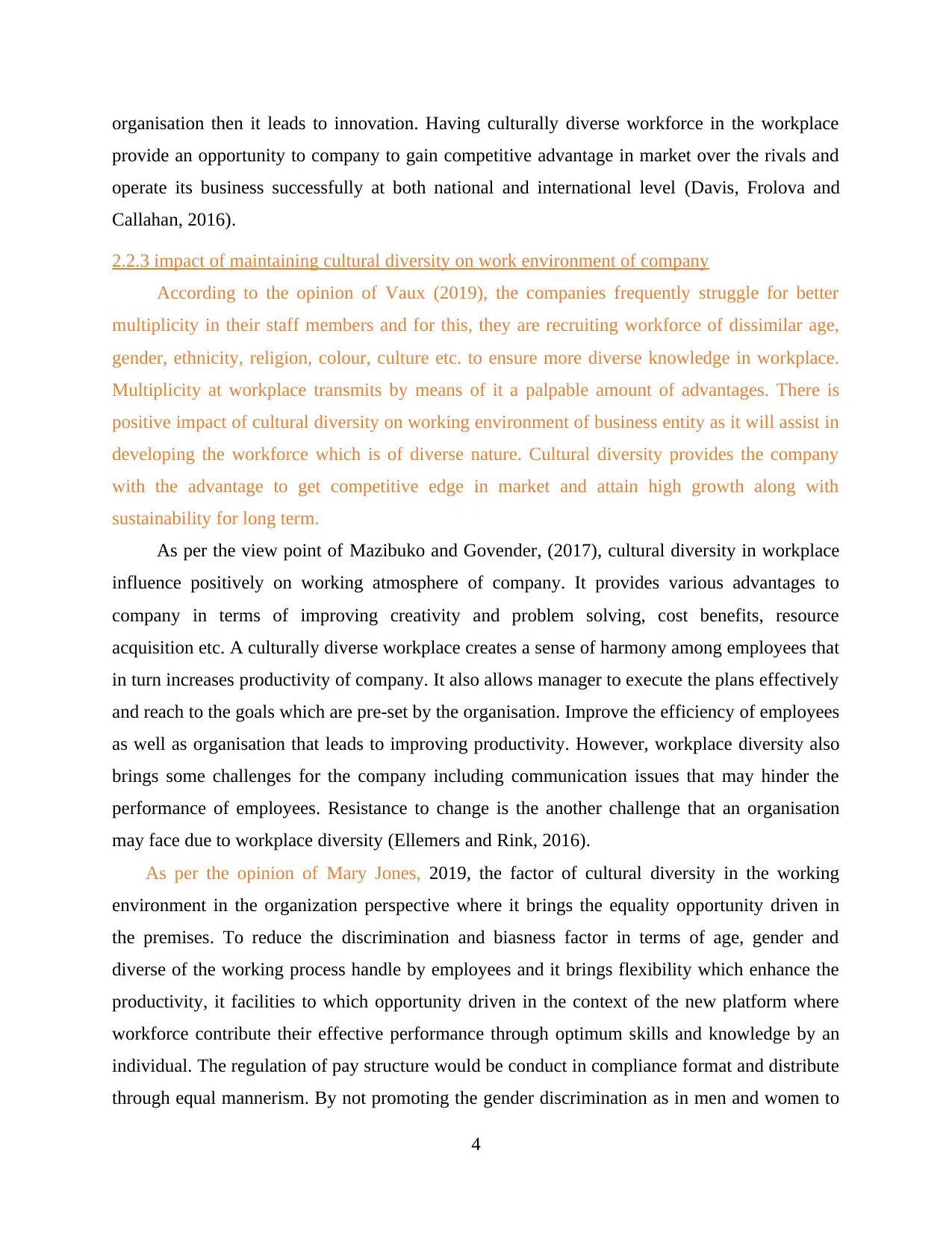
organisation then it leads to innovation. Having culturally diverse workforce in the workplace
provide an opportunity to company to gain competitive advantage in market over the rivals and
operate its business successfully at both national and international level (Davis, Frolova and
Callahan, 2016).
2.2.3 impact of maintaining cultural diversity on work environment of company
According to the opinion of Vaux (2019), the companies frequently struggle for better
multiplicity in their staff members and for this, they are recruiting workforce of dissimilar age,
gender, ethnicity, religion, colour, culture etc. to ensure more diverse knowledge in workplace.
Multiplicity at workplace transmits by means of it a palpable amount of advantages. There is
positive impact of cultural diversity on working environment of business entity as it will assist in
developing the workforce which is of diverse nature. Cultural diversity provides the company
with the advantage to get competitive edge in market and attain high growth along with
sustainability for long term.
As per the view point of Mazibuko and Govender, (2017), cultural diversity in workplace
influence positively on working atmosphere of company. It provides various advantages to
company in terms of improving creativity and problem solving, cost benefits, resource
acquisition etc. A culturally diverse workplace creates a sense of harmony among employees that
in turn increases productivity of company. It also allows manager to execute the plans effectively
and reach to the goals which are pre-set by the organisation. Improve the efficiency of employees
as well as organisation that leads to improving productivity. However, workplace diversity also
brings some challenges for the company including communication issues that may hinder the
performance of employees. Resistance to change is the another challenge that an organisation
may face due to workplace diversity (Ellemers and Rink, 2016).
As per the opinion of Mary Jones, 2019, the factor of cultural diversity in the working
environment in the organization perspective where it brings the equality opportunity driven in
the premises. To reduce the discrimination and biasness factor in terms of age, gender and
diverse of the working process handle by employees and it brings flexibility which enhance the
productivity, it facilities to which opportunity driven in the context of the new platform where
workforce contribute their effective performance through optimum skills and knowledge by an
individual. The regulation of pay structure would be conduct in compliance format and distribute
through equal mannerism. By not promoting the gender discrimination as in men and women to
4
provide an opportunity to company to gain competitive advantage in market over the rivals and
operate its business successfully at both national and international level (Davis, Frolova and
Callahan, 2016).
2.2.3 impact of maintaining cultural diversity on work environment of company
According to the opinion of Vaux (2019), the companies frequently struggle for better
multiplicity in their staff members and for this, they are recruiting workforce of dissimilar age,
gender, ethnicity, religion, colour, culture etc. to ensure more diverse knowledge in workplace.
Multiplicity at workplace transmits by means of it a palpable amount of advantages. There is
positive impact of cultural diversity on working environment of business entity as it will assist in
developing the workforce which is of diverse nature. Cultural diversity provides the company
with the advantage to get competitive edge in market and attain high growth along with
sustainability for long term.
As per the view point of Mazibuko and Govender, (2017), cultural diversity in workplace
influence positively on working atmosphere of company. It provides various advantages to
company in terms of improving creativity and problem solving, cost benefits, resource
acquisition etc. A culturally diverse workplace creates a sense of harmony among employees that
in turn increases productivity of company. It also allows manager to execute the plans effectively
and reach to the goals which are pre-set by the organisation. Improve the efficiency of employees
as well as organisation that leads to improving productivity. However, workplace diversity also
brings some challenges for the company including communication issues that may hinder the
performance of employees. Resistance to change is the another challenge that an organisation
may face due to workplace diversity (Ellemers and Rink, 2016).
As per the opinion of Mary Jones, 2019, the factor of cultural diversity in the working
environment in the organization perspective where it brings the equality opportunity driven in
the premises. To reduce the discrimination and biasness factor in terms of age, gender and
diverse of the working process handle by employees and it brings flexibility which enhance the
productivity, it facilities to which opportunity driven in the context of the new platform where
workforce contribute their effective performance through optimum skills and knowledge by an
individual. The regulation of pay structure would be conduct in compliance format and distribute
through equal mannerism. By not promoting the gender discrimination as in men and women to
4
Paraphrase This Document
Need a fresh take? Get an instant paraphrase of this document with our AI Paraphraser

procuring the more importance to the men as in salary basis and promotion where women are not
get equal rights. This type of propaganda should not have promoted in the organization premises
it will create conflict in the organization. By enhancing the effective laws and acts should
applicable like employment act, sexual harassment, bonus acts and many more all these
regulations will persuasion positive environment in internal premises (Enoksen, 2016).
2.2.4 the way cultural diversity assists in promotion of innovation in company
According to the Hewlett, Marshall and Sherbin (2013), Maximum of the directors of an
organisations are accepting that managers advantage as of a varied staff, nonetheless the
impression can be solid to display or enumerate, particularly at what time it originates to
determine in what way assortment impacts a business’s aptitude to revolutionise. Assortment
helps an organisation by unlocking innovation and diverse market growth. Workstation
assortment solves novelty by developing a setting where “outdoor the box” thoughts are caught.
Whilst sections practise a significant mass and leader’s value differences, entire workforce can
analyse senior persons to drive to paddle for enthralling thoughts as well as can encourage those
within custody of resources to organize capitals to create those thoughts (Fletcher, 2017).
As per the view point of Ruthie Miller, (2018), cultural diversity promotes innovation by
developing an environment where all the employees think out of the box. Cultural diversity
brings diversity of opinions and ideas can lead to creativity and fuel innovation. When multiple
perspectives and background are represented and the differences are valued by leaders, all the
workers feel comfortable in sharing ideas and opinions. Apart from this, in today's economy,
competition for talent is high. If an organisation wants to attract talent, it is very necessary to
cultivate an inclusive as well as diverse workforce (5 Reasons of Diversity Drives Innovation to
Small Businesses, 2018). By emphasizing on providing safe environment to make mistakes and
decisions to employees, the organisation can protect budding innovation in workplace.
Innovation and diversity are highly interlinked with each other as if workforce with diverse skills
and competencies are available in the workplace then it helps in bringing innovation.
As per the opinion of the Louise Petty, 2016. By the cultural diversity to scrutinize the
lacking factor which helps to improvisation the organizational structure as well as enhance the
new creativity and innovative activity through providing the platform where participation is
engaging for sharing new ideas related with working related. By facilitating the training program
where underperformer employees could learn new skills and techniques to assort in their work it
5
get equal rights. This type of propaganda should not have promoted in the organization premises
it will create conflict in the organization. By enhancing the effective laws and acts should
applicable like employment act, sexual harassment, bonus acts and many more all these
regulations will persuasion positive environment in internal premises (Enoksen, 2016).
2.2.4 the way cultural diversity assists in promotion of innovation in company
According to the Hewlett, Marshall and Sherbin (2013), Maximum of the directors of an
organisations are accepting that managers advantage as of a varied staff, nonetheless the
impression can be solid to display or enumerate, particularly at what time it originates to
determine in what way assortment impacts a business’s aptitude to revolutionise. Assortment
helps an organisation by unlocking innovation and diverse market growth. Workstation
assortment solves novelty by developing a setting where “outdoor the box” thoughts are caught.
Whilst sections practise a significant mass and leader’s value differences, entire workforce can
analyse senior persons to drive to paddle for enthralling thoughts as well as can encourage those
within custody of resources to organize capitals to create those thoughts (Fletcher, 2017).
As per the view point of Ruthie Miller, (2018), cultural diversity promotes innovation by
developing an environment where all the employees think out of the box. Cultural diversity
brings diversity of opinions and ideas can lead to creativity and fuel innovation. When multiple
perspectives and background are represented and the differences are valued by leaders, all the
workers feel comfortable in sharing ideas and opinions. Apart from this, in today's economy,
competition for talent is high. If an organisation wants to attract talent, it is very necessary to
cultivate an inclusive as well as diverse workforce (5 Reasons of Diversity Drives Innovation to
Small Businesses, 2018). By emphasizing on providing safe environment to make mistakes and
decisions to employees, the organisation can protect budding innovation in workplace.
Innovation and diversity are highly interlinked with each other as if workforce with diverse skills
and competencies are available in the workplace then it helps in bringing innovation.
As per the opinion of the Louise Petty, 2016. By the cultural diversity to scrutinize the
lacking factor which helps to improvisation the organizational structure as well as enhance the
new creativity and innovative activity through providing the platform where participation is
engaging for sharing new ideas related with working related. By facilitating the training program
where underperformer employees could learn new skills and techniques to assort in their work it
5
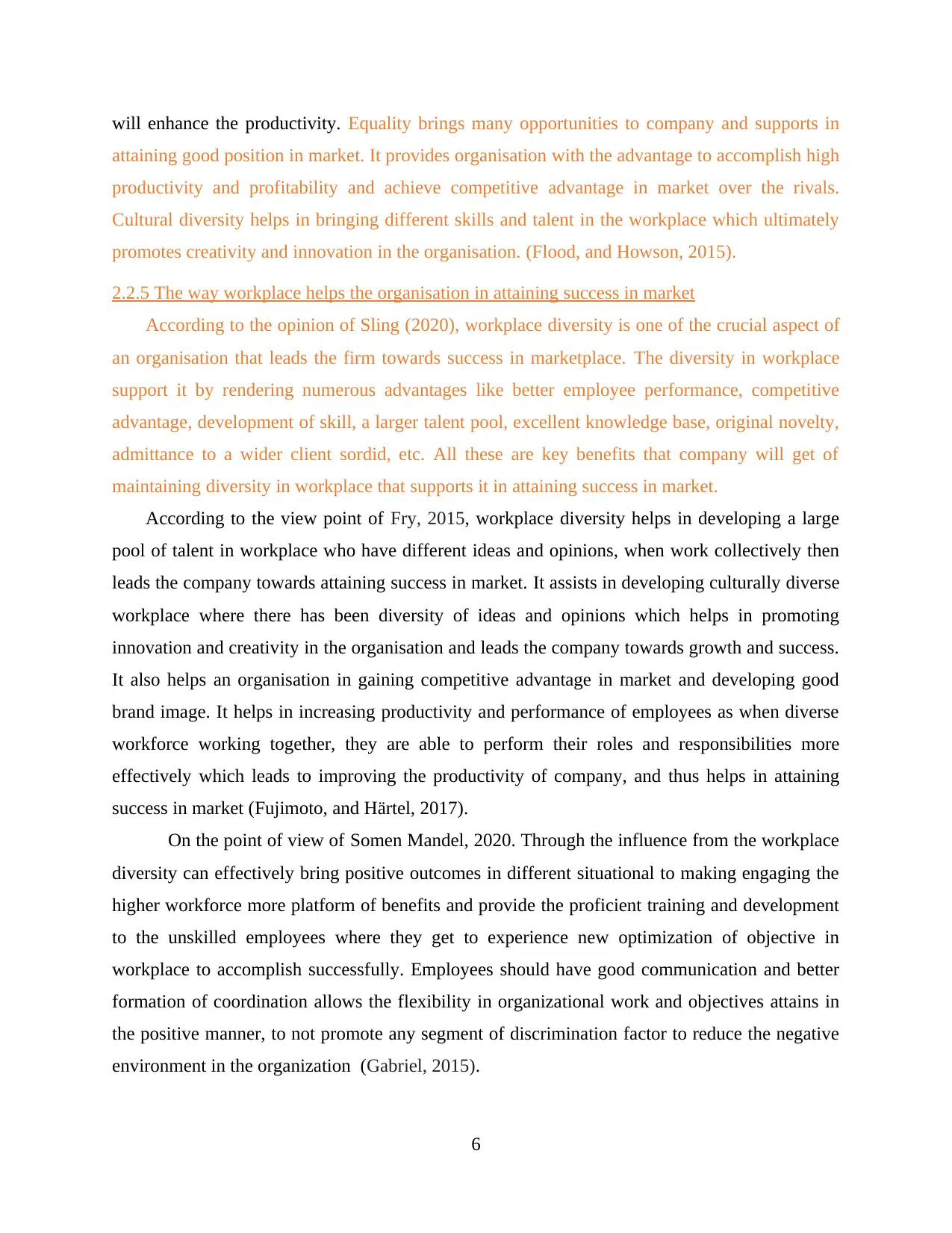
will enhance the productivity. Equality brings many opportunities to company and supports in
attaining good position in market. It provides organisation with the advantage to accomplish high
productivity and profitability and achieve competitive advantage in market over the rivals.
Cultural diversity helps in bringing different skills and talent in the workplace which ultimately
promotes creativity and innovation in the organisation. (Flood, and Howson, 2015).
2.2.5 The way workplace helps the organisation in attaining success in market
According to the opinion of Sling (2020), workplace diversity is one of the crucial aspect of
an organisation that leads the firm towards success in marketplace. The diversity in workplace
support it by rendering numerous advantages like better employee performance, competitive
advantage, development of skill, a larger talent pool, excellent knowledge base, original novelty,
admittance to a wider client sordid, etc. All these are key benefits that company will get of
maintaining diversity in workplace that supports it in attaining success in market.
According to the view point of Fry, 2015, workplace diversity helps in developing a large
pool of talent in workplace who have different ideas and opinions, when work collectively then
leads the company towards attaining success in market. It assists in developing culturally diverse
workplace where there has been diversity of ideas and opinions which helps in promoting
innovation and creativity in the organisation and leads the company towards growth and success.
It also helps an organisation in gaining competitive advantage in market and developing good
brand image. It helps in increasing productivity and performance of employees as when diverse
workforce working together, they are able to perform their roles and responsibilities more
effectively which leads to improving the productivity of company, and thus helps in attaining
success in market (Fujimoto, and Härtel, 2017).
On the point of view of Somen Mandel, 2020. Through the influence from the workplace
diversity can effectively bring positive outcomes in different situational to making engaging the
higher workforce more platform of benefits and provide the proficient training and development
to the unskilled employees where they get to experience new optimization of objective in
workplace to accomplish successfully. Employees should have good communication and better
formation of coordination allows the flexibility in organizational work and objectives attains in
the positive manner, to not promote any segment of discrimination factor to reduce the negative
environment in the organization (Gabriel, 2015).
6
attaining good position in market. It provides organisation with the advantage to accomplish high
productivity and profitability and achieve competitive advantage in market over the rivals.
Cultural diversity helps in bringing different skills and talent in the workplace which ultimately
promotes creativity and innovation in the organisation. (Flood, and Howson, 2015).
2.2.5 The way workplace helps the organisation in attaining success in market
According to the opinion of Sling (2020), workplace diversity is one of the crucial aspect of
an organisation that leads the firm towards success in marketplace. The diversity in workplace
support it by rendering numerous advantages like better employee performance, competitive
advantage, development of skill, a larger talent pool, excellent knowledge base, original novelty,
admittance to a wider client sordid, etc. All these are key benefits that company will get of
maintaining diversity in workplace that supports it in attaining success in market.
According to the view point of Fry, 2015, workplace diversity helps in developing a large
pool of talent in workplace who have different ideas and opinions, when work collectively then
leads the company towards attaining success in market. It assists in developing culturally diverse
workplace where there has been diversity of ideas and opinions which helps in promoting
innovation and creativity in the organisation and leads the company towards growth and success.
It also helps an organisation in gaining competitive advantage in market and developing good
brand image. It helps in increasing productivity and performance of employees as when diverse
workforce working together, they are able to perform their roles and responsibilities more
effectively which leads to improving the productivity of company, and thus helps in attaining
success in market (Fujimoto, and Härtel, 2017).
On the point of view of Somen Mandel, 2020. Through the influence from the workplace
diversity can effectively bring positive outcomes in different situational to making engaging the
higher workforce more platform of benefits and provide the proficient training and development
to the unskilled employees where they get to experience new optimization of objective in
workplace to accomplish successfully. Employees should have good communication and better
formation of coordination allows the flexibility in organizational work and objectives attains in
the positive manner, to not promote any segment of discrimination factor to reduce the negative
environment in the organization (Gabriel, 2015).
6
⊘ This is a preview!⊘
Do you want full access?
Subscribe today to unlock all pages.

Trusted by 1+ million students worldwide
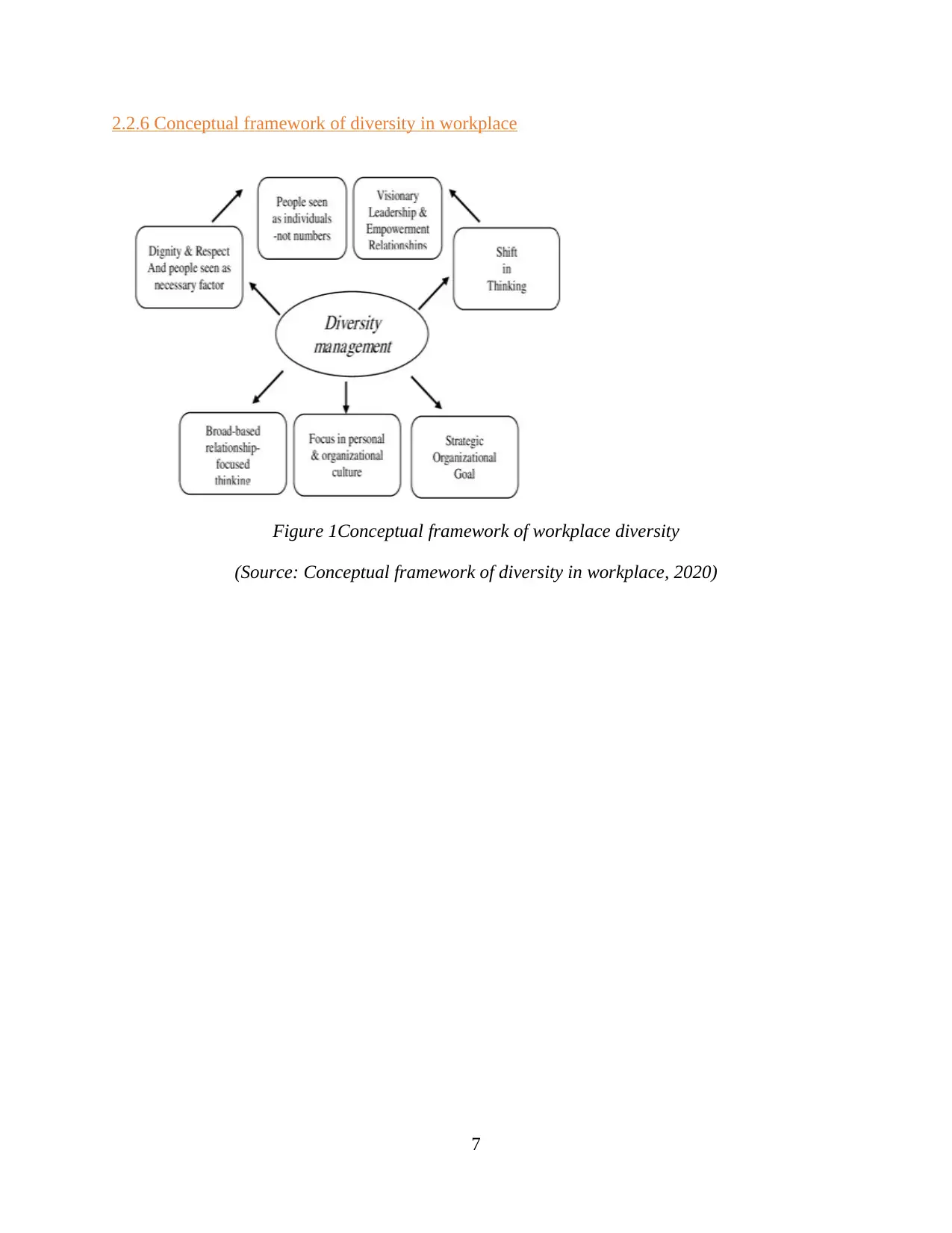
2.2.6 Conceptual framework of diversity in workplace
Figure 1Conceptual framework of workplace diversity
(Source: Conceptual framework of diversity in workplace, 2020)
7
Figure 1Conceptual framework of workplace diversity
(Source: Conceptual framework of diversity in workplace, 2020)
7
Paraphrase This Document
Need a fresh take? Get an instant paraphrase of this document with our AI Paraphraser
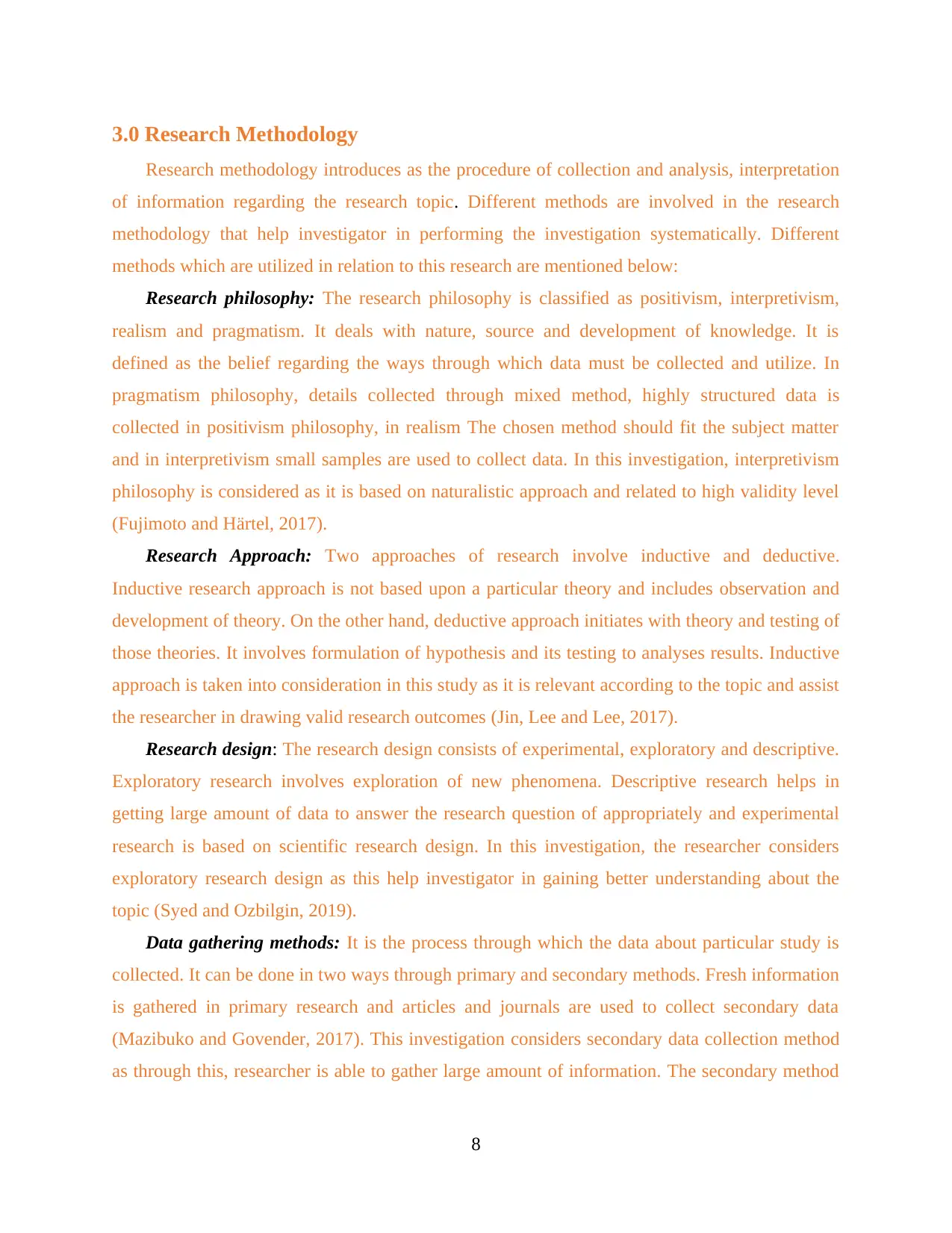
3.0 Research Methodology
Research methodology introduces as the procedure of collection and analysis, interpretation
of information regarding the research topic. Different methods are involved in the research
methodology that help investigator in performing the investigation systematically. Different
methods which are utilized in relation to this research are mentioned below:
Research philosophy: The research philosophy is classified as positivism, interpretivism,
realism and pragmatism. It deals with nature, source and development of knowledge. It is
defined as the belief regarding the ways through which data must be collected and utilize. In
pragmatism philosophy, details collected through mixed method, highly structured data is
collected in positivism philosophy, in realism The chosen method should fit the subject matter
and in interpretivism small samples are used to collect data. In this investigation, interpretivism
philosophy is considered as it is based on naturalistic approach and related to high validity level
(Fujimoto and Härtel, 2017).
Research Approach: Two approaches of research involve inductive and deductive.
Inductive research approach is not based upon a particular theory and includes observation and
development of theory. On the other hand, deductive approach initiates with theory and testing of
those theories. It involves formulation of hypothesis and its testing to analyses results. Inductive
approach is taken into consideration in this study as it is relevant according to the topic and assist
the researcher in drawing valid research outcomes (Jin, Lee and Lee, 2017).
Research design: The research design consists of experimental, exploratory and descriptive.
Exploratory research involves exploration of new phenomena. Descriptive research helps in
getting large amount of data to answer the research question of appropriately and experimental
research is based on scientific research design. In this investigation, the researcher considers
exploratory research design as this help investigator in gaining better understanding about the
topic (Syed and Ozbilgin, 2019).
Data gathering methods: It is the process through which the data about particular study is
collected. It can be done in two ways through primary and secondary methods. Fresh information
is gathered in primary research and articles and journals are used to collect secondary data
(Mazibuko and Govender, 2017). This investigation considers secondary data collection method
as through this, researcher is able to gather large amount of information. The secondary method
8
Research methodology introduces as the procedure of collection and analysis, interpretation
of information regarding the research topic. Different methods are involved in the research
methodology that help investigator in performing the investigation systematically. Different
methods which are utilized in relation to this research are mentioned below:
Research philosophy: The research philosophy is classified as positivism, interpretivism,
realism and pragmatism. It deals with nature, source and development of knowledge. It is
defined as the belief regarding the ways through which data must be collected and utilize. In
pragmatism philosophy, details collected through mixed method, highly structured data is
collected in positivism philosophy, in realism The chosen method should fit the subject matter
and in interpretivism small samples are used to collect data. In this investigation, interpretivism
philosophy is considered as it is based on naturalistic approach and related to high validity level
(Fujimoto and Härtel, 2017).
Research Approach: Two approaches of research involve inductive and deductive.
Inductive research approach is not based upon a particular theory and includes observation and
development of theory. On the other hand, deductive approach initiates with theory and testing of
those theories. It involves formulation of hypothesis and its testing to analyses results. Inductive
approach is taken into consideration in this study as it is relevant according to the topic and assist
the researcher in drawing valid research outcomes (Jin, Lee and Lee, 2017).
Research design: The research design consists of experimental, exploratory and descriptive.
Exploratory research involves exploration of new phenomena. Descriptive research helps in
getting large amount of data to answer the research question of appropriately and experimental
research is based on scientific research design. In this investigation, the researcher considers
exploratory research design as this help investigator in gaining better understanding about the
topic (Syed and Ozbilgin, 2019).
Data gathering methods: It is the process through which the data about particular study is
collected. It can be done in two ways through primary and secondary methods. Fresh information
is gathered in primary research and articles and journals are used to collect secondary data
(Mazibuko and Govender, 2017). This investigation considers secondary data collection method
as through this, researcher is able to gather large amount of information. The secondary method
8

of collecting data helps the researcher as this will help in gathering adequate amount of data over
the particular research topic which assist in ensuring the accuracy of research outcomes.
Sampling: It is referred as the process through which researcher select sample size from
large population. In context of probability sampling, the chances of selection for each respondent
is equal whereas, the selection is done on the basis of subjective judgement. In this investigation,
random sampling is used to select sample from population. The main reason behind selecting this
sampling is that it provides each respondent with similar chances to get select as a participant
from research (Gordon, 2018). It also helps in ensuring that no biasness takes place at the time of
choosing respondents. 20 respondents are selected who are the employees of Volkswagen.
Method of data analysis: In research, data can be analysed through qualitative and
quantitative methods. In quantitative data analysis, data can be analyzed through descriptive and
inferential analysis. And the qualitative data can be analysed through narrative analysis,
grounded theory, content analysis and discourse analysis. In this study, the data is analysed
through descriptive analysis method as this assist researcher in find out absolute numbers for
summarizing individual variables.
Reliability: Research reliability is defined as the extent to which the methods of research
produces consistent and stable outcomes. In research, it is highly important aspect as it assists in
ensuring the affective outcomes of research. It also helps in ensuring that it has positive
implication on other areas of study and allow a researcher to develop further investigation in the
similar field. In order to ensure reliability of data, the research will gather the data from authentic
and relevant sources and ensure that the data older than five years can not be included in the
investigation (Hideg and Ferris, 2016).
Validity: Research validity is defined as an indication of how is effective the research is. At
the time of collecting data, it is required by researcher that it ensures validity of research.
Validity in collection of data means that the findings of research truly represent phenomena that
an individual claiming to measure. In order to ensure the validity of data, researcher will take
into consideration various aspects at the time of collecting data and drawing outcomes. Apart
from this, the researcher ensures that all the data is collected through authentic sources so that
valid outcomes of investigation can be drawn (Jin, Lee, and Lee, 2017).
Limitations of study: Limitations of research includes those constraints that influence the
outcomes of research. There are some limitations in the study including lack of reliable data
9
the particular research topic which assist in ensuring the accuracy of research outcomes.
Sampling: It is referred as the process through which researcher select sample size from
large population. In context of probability sampling, the chances of selection for each respondent
is equal whereas, the selection is done on the basis of subjective judgement. In this investigation,
random sampling is used to select sample from population. The main reason behind selecting this
sampling is that it provides each respondent with similar chances to get select as a participant
from research (Gordon, 2018). It also helps in ensuring that no biasness takes place at the time of
choosing respondents. 20 respondents are selected who are the employees of Volkswagen.
Method of data analysis: In research, data can be analysed through qualitative and
quantitative methods. In quantitative data analysis, data can be analyzed through descriptive and
inferential analysis. And the qualitative data can be analysed through narrative analysis,
grounded theory, content analysis and discourse analysis. In this study, the data is analysed
through descriptive analysis method as this assist researcher in find out absolute numbers for
summarizing individual variables.
Reliability: Research reliability is defined as the extent to which the methods of research
produces consistent and stable outcomes. In research, it is highly important aspect as it assists in
ensuring the affective outcomes of research. It also helps in ensuring that it has positive
implication on other areas of study and allow a researcher to develop further investigation in the
similar field. In order to ensure reliability of data, the research will gather the data from authentic
and relevant sources and ensure that the data older than five years can not be included in the
investigation (Hideg and Ferris, 2016).
Validity: Research validity is defined as an indication of how is effective the research is. At
the time of collecting data, it is required by researcher that it ensures validity of research.
Validity in collection of data means that the findings of research truly represent phenomena that
an individual claiming to measure. In order to ensure the validity of data, researcher will take
into consideration various aspects at the time of collecting data and drawing outcomes. Apart
from this, the researcher ensures that all the data is collected through authentic sources so that
valid outcomes of investigation can be drawn (Jin, Lee, and Lee, 2017).
Limitations of study: Limitations of research includes those constraints that influence the
outcomes of research. There are some limitations in the study including lack of reliable data
9
⊘ This is a preview!⊘
Do you want full access?
Subscribe today to unlock all pages.

Trusted by 1+ million students worldwide
1 out of 21
Related Documents
Your All-in-One AI-Powered Toolkit for Academic Success.
+13062052269
info@desklib.com
Available 24*7 on WhatsApp / Email
![[object Object]](/_next/static/media/star-bottom.7253800d.svg)
Unlock your academic potential
Copyright © 2020–2025 A2Z Services. All Rights Reserved. Developed and managed by ZUCOL.




